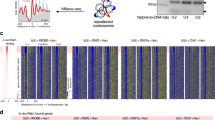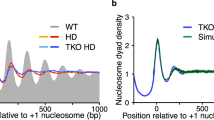Abstract
ATP-dependent chromatin remodeling complexes are implicated in many areas of chromosome biology. However, the physiological role of many of these enzymes is still unclear. In budding yeast, the Isw2 complex slides nucleosomes along DNA. By analyzing the native chromatin structure of Isw2 targets, we have found that nucleosomes adopt default, DNA-directed positions when ISW2 is deleted. We provide evidence that Isw2 targets contain DNA sequences that are inhibitory to nucleosome formation and that these sequences facilitate the formation of nuclease-accessible open chromatin in the absence of Isw2. Our data show that the biological function of Isw2 is to position nucleosomes onto unfavorable DNA. These results reveal that antagonistic forces of Isw2 and the DNA sequence can control nucleosome positioning and genomic access in vivo.
This is a preview of subscription content, access via your institution
Access options
Subscribe to this journal
Receive 12 print issues and online access
$189.00 per year
only $15.75 per issue
Buy this article
- Purchase on Springer Link
- Instant access to full article PDF
Prices may be subject to local taxes which are calculated during checkout






Similar content being viewed by others
References
Luger, K., Mader, A.W., Richmond, R.K., Sargent, D.F. & Richmond, T.J. Crystal structure of the nucleosome core particle at 2.8 Å resolution. Nature 389, 251–260 (1997).
Ehrenhofer-Murray, A.E. Chromatin dynamics at DNA replication, transcription and repair. Eur. J. Biochem. 271, 2335–2349 (2004).
Truss, M., Bartsch, J., Hache, R.S. & Beato, M. Chromatin structure modulates transcription factor binding to the mouse mammary tumor virus (MMTV) promoter. J. Steroid Biochem. Mol. Biol. 47, 1–10 (1993).
Sekinger, E.A., Moqtaderi, Z. & Struhl, K. Intrinsic histone-DNA interactions and low nucleosome density are important for preferential accessibility of promoter regions in yeast. Mol. Cell 18, 735–748 (2005).
Lee, C.K., Shibata, Y., Rao, B., Strahl, B.D. & Lieb, J.D. Evidence for nucleosome depletion at active regulatory regions genome-wide. Nat. Genet. 36, 900–905 (2004).
Yuan, G.C. et al. Genome-scale identification of nucleosome positions in S. cerevisiae. Science 309, 626–630 (2005).
Behe, M.J. An overabundance of long oligopurine tracts occurs in the genome of simple and complex eukaryotes. Nucleic Acids Res. 23, 689–695 (1995).
Iyer, V. & Struhl, K. Poly(dA:dT), a ubiquitous promoter element that stimulates transcription via its intrinsic DNA structure. EMBO J. 14, 2570–2579 (1995).
Kunkel, G.R. & Martinson, H.G. Nucleosomes will not form on double-stranded RNa or over poly(dA).poly(dT) tracts in recombinant DNA. Nucleic Acids Res. 9, 6869–6888 (1981).
Anderson, J.D. & Widom, J. Poly(dA-dT) promoter elements increase the equilibrium accessibility of nucleosomal DNA target sites. Mol. Cell. Biol. 21, 3830–3839 (2001).
Puhl, H.L., Gudibande, S.R. & Behe, M.J. Poly[d(A.T)] and other synthetic polydeoxynucleotides containing oligoadenosine tracts form nucleosomes easily. J. Mol. Biol. 222, 1149–1160 (1991).
Losa, R., Omari, S. & Thoma, F. Poly(dA).poly(dT) rich sequences are not sufficient to exclude nucleosome formation in a constitutive yeast promoter. Nucleic Acids Res. 18, 3495–3502 (1990).
Verdone, L., Camilloni, G., Di Mauro, E. & Caserta, M. Chromatin remodeling during Saccharomyces cerevisiae ADH2 gene activation. Mol. Cell. Biol. 16, 1978–1988 (1996).
Langst, G. & Becker, P.B. Nucleosome remodeling: one mechanism, many phenomena? Biochim. Biophys. Acta 1677, 58–63 (2004).
Hamiche, A., Sandaltzopoulos, R., Gdula, D.A. & Wu, C. ATP-dependent histone octamer sliding mediated by the chromatin remodeling complex NURF. Cell 97, 833–842 (1999).
Langst, G., Bonte, E.J., Corona, D.F. & Becker, P.B. Nucleosome movement by CHRAC and ISWI without disruption or trans-displacement of the histone octamer. Cell 97, 843–852 (1999).
Fyodorov, D.V. & Kadonaga, J.T. Dynamics of ATP-dependent chromatin assembly by ACF. Nature 418, 897–900 (2002).
Ito, T., Bulger, M., Pazin, M.J., Kobayashi, R. & Kadonaga, J.T. ACF, an ISWI-containing and ATP-utilizing chromatin assembly and remodeling factor. Cell 90, 145–155 (1997).
Goldmark, J.P., Fazzio, T.G., Estep, P.W., Church, G.M. & Tsukiyama, T. The Isw2 chromatin remodeling complex represses early meiotic genes upon recruitment by Ume6p. Cell 103, 423–433 (2000).
Kent, N.A., Karabetsou, N., Politis, P.K. & Mellor, J. In vivo chromatin remodeling by yeast ISWI homologs Isw1p and Isw2p. Genes Dev. 15, 619–626 (2001).
Fazzio, T.G. et al. Widespread collaboration of Isw2 and Sin3-Rpd3 chromatin remodeling complexes in transcriptional repression. Mol. Cell. Biol. 21, 6450–6460 (2001).
Badenhorst, P., Voas, M., Rebay, I. & Wu, C. Biological functions of the ISWI chromatin remodeling complex NURF. Genes Dev. 16, 3186–3198 (2002).
Yasui, D., Miyano, M., Cai, S., Varga-Weisz, P. & Kohwi-Shigematsu, T. SATB1 targets chromatin remodelling to regulate genes over long distances. Nature 419, 641–645 (2002).
Deuring, R. et al. The ISWI chromatin-remodeling protein is required for gene expression and the maintenance of higher order chromatin structure in vivo. Mol. Cell 5, 355–365 (2000).
Collins, N. et al. An ACF1-ISWI chromatin-remodeling complex is required for DNA replication through heterochromatin. Nat. Genet. 32, 627–632 (2002).
Poot, R.A. et al. The Williams syndrome transcription factor interacts with PCNA to target chromatin remodelling by ISWI to replication foci. Nat. Cell Biol. 6, 1236–1244 (2004).
Fyodorov, D.V., Blower, M.D., Karpen, G.H. & Kadonaga, J.T. Acf1 confers unique activities to ACF/CHRAC and promotes the formation rather than disruption of chromatin in vivo. Genes Dev. 18, 170–183 (2004).
Zhou, Y., Santoro, R. & Grummt, I. The chromatin remodeling complex NoRC targets HDAC1 to the ribosomal gene promoter and represses RNA polymerase I transcription. EMBO J. 21, 4632–4640 (2002).
Hakimi, M.A. et al. A chromatin remodelling complex that loads cohesin onto human chromosomes. Nature 418, 994–998 (2002).
Tsukiyama, T., Palmer, J., Landel, C.C., Shiloach, J. & Wu, C. Characterization of the imitation switch subfamily of ATP-dependent chromatin-remodeling factors in Saccharomyces cerevisiae. Genes Dev. 13, 686–697 (1999).
McConnell, A.D., Gelbart, M.E. & Tsukiyama, T. Histone fold protein Dls1p is required for Isw2-dependent chromatin remodeling in vivo. Mol. Cell. Biol. 24, 2605–2613 (2004).
Zhang, Z. & Reese, J.C. Ssn6-Tup1 requires the ISW2 complex to position nucleosomes in Saccharomyces cerevisiae. EMBO J. 23, 2246–2257 (2004).
Gelbart, M.E., Bachman, N., Delrow, J., Boeke, J.D. & Tsukiyama, T. Genome-wide identification of Isw2 chromatin-remodeling targets by localization of a catalytically inactive mutant. Genes Dev. 19, 942–954 (2005).
Fazzio, T.G. & Tsukiyama, T. Chromatin remodeling in vivo: evidence for a nucleosome sliding mechanism. Mol. Cell 12, 1333–1340 (2003).
Bachman, N., Gelbart, M.E., Tsukiyama, T. & Boeke, J.D. TFIIIB subunit Bdp1p is required for periodic integration of the Ty1 retrotransposon and targeting of Isw2p to S. cerevisiae tDNAs. Genes Dev. 19, 955–964 (2005).
Szeto, L., Fafalios, M.K., Zhong, H., Vershon, A.K. & Broach, J.R. Alpha2p controls donor preference during mating type interconversion in yeast by inactivating a recombinational enhancer of chromosome III. Genes Dev. 11, 1899–1911 (1997).
Wu, X. & Haber, J.E. A 700 bp cis-acting region controls mating-type dependent recombination along the entire left arm of yeast chromosome III. Cell 87, 277–285 (1996).
Ruan, C., Workman, J.L. & Simpson, R.T. The DNA repair protein yKu80 regulates the function of recombination enhancer during yeast mating type switching. Mol. Cell. Biol. 25, 8476–8485 (2005).
Weiss, K. & Simpson, R.T. Cell type-specific chromatin organization of the region that governs directionality of yeast mating type switching. EMBO J. 16, 4352–4360 (1997).
Brehm, A. et al. dMi-2 and ISWI chromatin remodelling factors have distinct nucleosome binding and mobilization properties. EMBO J. 19, 4332–4341 (2000).
Whitehouse, I., Stockdale, C., Flaus, A., Szczelkun, M.D. & Owen-Hughes, T. Evidence for DNA translocation by the ISWI chromatin-remodeling enzyme. Mol. Cell. Biol. 23, 1935–1945 (2003).
Kagalwala, M.N., Glaus, B.J., Dang, W., Zofall, M. & Bartholomew, B. Topography of the ISW2-nucleosome complex: insights into nucleosome spacing and chromatin remodeling. EMBO J. 23, 2092–2104 (2004).
Fazzio, T.G., Gelbart, M.E. & Tsukiyama, T. Two distinct mechanisms of chromatin interaction by the isw2 chromatin remodeling complex in vivo. Mol. Cell. Biol. 25, 9165–9174 (2005).
Wu, C. et al. Mcm1 regulates donor preference controlled by the recombination enhancer in Saccharomyces mating-type switching. Genes Dev. 12, 1726–1737 (1998).
Sun, K., Coic, E., Zhou, Z., Durrens, P. & Haber, J.E. Saccharomyces forkhead protein Fkh1 regulates donor preference during mating-type switching through the recombination enhancer. Genes Dev. 16, 2085–2096 (2002).
Ercan, S., Reese, J.C., Workman, J.L. & Simpson, R.T. Yeast recombination enhancer is stimulated by transcription activation. Mol. Cell. Biol. 25, 7976–7987 (2005).
Blackwood, E.M. & Kadonaga, J.T. Going the distance: a current view of enhancer action. Science 281, 60–63 (1998).
West, A.G., Gaszner, M. & Felsenfeld, G. Insulators: many functions, many mechanisms. Genes Dev. 16, 271–288 (2002).
Stalder, J. et al. Tissue-specific DNA cleavages in the globin chromatin domain introduced by DNAase I. Cell 20, 451–460 (1980).
Wootton, J.C. & Federhen, S. Analysis of compositionally biased regions in sequence databases. Methods Enzymol. 266, 554–571 (1996).
Acknowledgements
We thank members of the Tsukiyama, Biggins and Henikoff laboratories for helpful discussions; members of the Tsukiyama, Owen-Hughes and Hahn laboratories for critical reading of the manuscript; and G. Mizuguchi and C. Wu (National Cancer Institute, US National Institutes of Health) for the recombinant Drosophila histone octamer. This work was supported by US National Institutes of Health grant GM58465. T.T. is a Leukemia and Lymphoma Society Scholar.
Author information
Authors and Affiliations
Corresponding author
Ethics declarations
Competing interests
The authors declare no competing financial interests.
Supplementary information
Supplementary Fig. 1
DNA sequence of N1a variants (PDF 1428 kb)
Supplementary Fig. 2
Chromatin structure at POT1 in repressing and activating conditions (PDF 1777 kb)
Supplementary Fig. 3
Sequence characteristics and chromatin structure at the recombination enhancer (PDF 3321 kb)
Rights and permissions
About this article
Cite this article
Whitehouse, I., Tsukiyama, T. Antagonistic forces that position nucleosomes in vivo. Nat Struct Mol Biol 13, 633–640 (2006). https://doi.org/10.1038/nsmb1111
Received:
Accepted:
Published:
Issue Date:
DOI: https://doi.org/10.1038/nsmb1111
This article is cited by
-
Termination of the unfolded protein response is guided by ER stress-induced HAC1 mRNA nuclear retention
Nature Communications (2022)
-
CORENup: a combination of convolutional and recurrent deep neural networks for nucleosome positioning identification
BMC Bioinformatics (2020)
-
ASF1 and the SWI/SNF complex interact functionally during nucleosome displacement, while FACT is required for nucleosome reassembly at yeast heat shock gene promoters during sustained stress
Cell Stress and Chaperones (2015)
-
Determinants of nucleosome positioning
Nature Structural & Molecular Biology (2013)
-
Nucleosome sliding mechanisms: new twists in a looped history
Nature Structural & Molecular Biology (2013)



